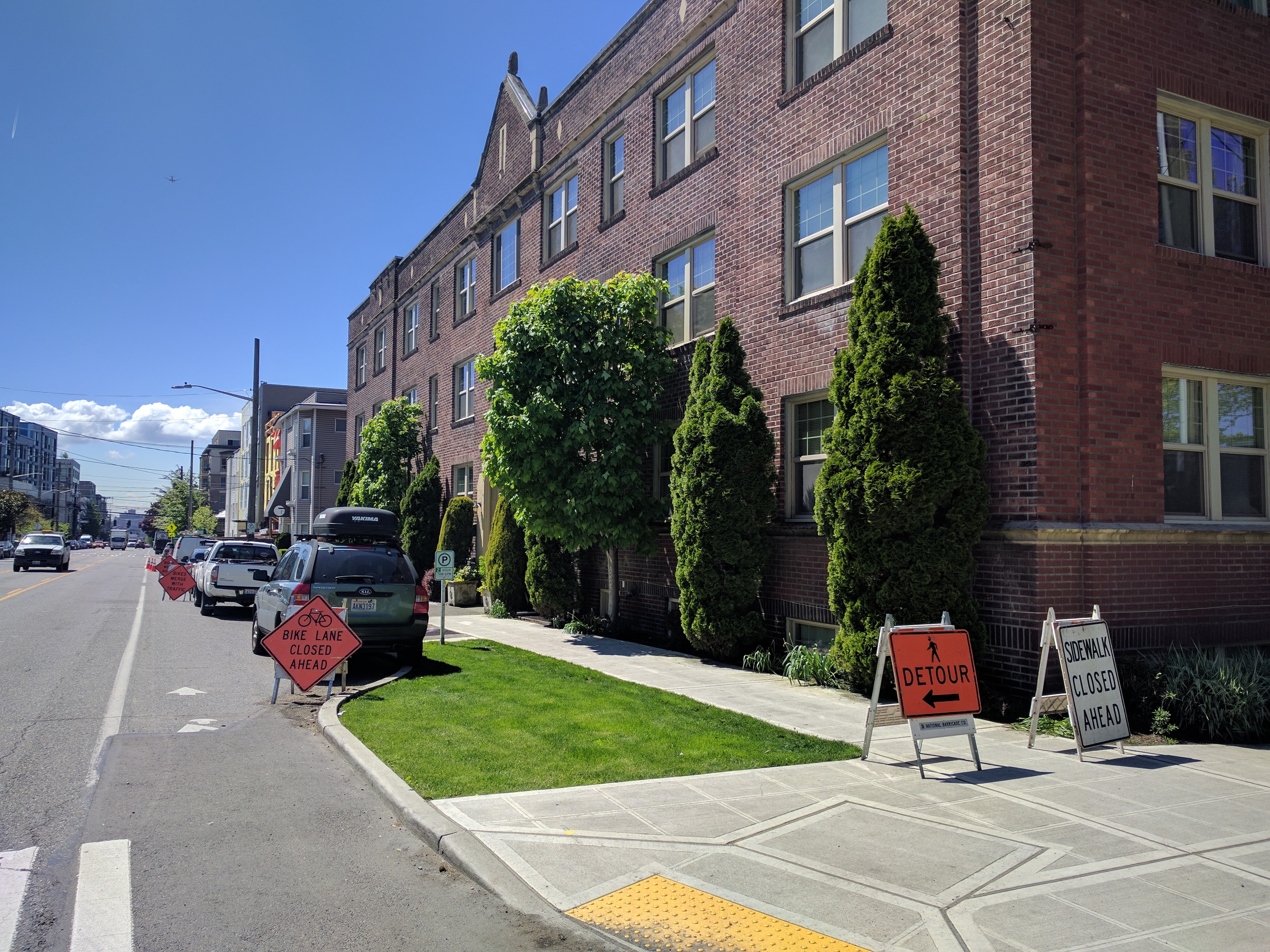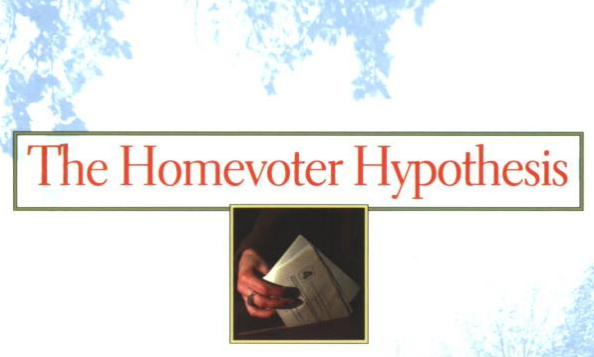The first public meeting on zoning I ever attended compared micro-housing construction to bombing cities. For many urbanists, comments like this are used to identify and categorize people as NIMBYs. The NIMBY (Not In My Backyard) label is frequently used to belittle or demean but it also tells a narrative about motivations and politics. While the controversial NIMBY label is a common, well-understood term, “homevoter” is portrayed as it’s equivalent from the academic sphere. But are NIMBYs and homevoters really the same?
History Of The Homevoter Hypothesis
The word ‘homevoter’ has a distinct history and meaning, explained by the homevoter hypothesis.
In 1956, Charles Tiebout published A Pure Theory Of Local Expenditures as a direct response to Paul Samuelson’s theory about public goods. Samuelson created a model suggesting public goods couldn’t be delivered efficiently due to issues like the free-rider problem. Tiebout countered, theorizing that communities will compete for residents. Competition will result in services, taxes, and amenities that efficiently reflect what residents want, he argued.

William Fischel admired Tiebout’s theory and coined the word ‘homevoter.’ In his book The Homevoter Hypothesis, he explained how homevoters underpin the Tiebout theory. Although the two never met, Fischel dedicated his book to Tiebout and spent a chapter providing personal background, remarking on his personality and humor. Fischel’s book and the homevoter hypothesis attempt to explain on-the-ground mechanisms that underpin Tiebout’s model.
The book begins by observing that many people’s largest asset is their home and that it’s uniquely vulnerable. The asset’s future value can’t really be insured or diversified. People are left with few options to protect its value, and Fischel believes they resort to political activism. These politically engaged homeowners are ‘homevoters.’ Since homeowners are a majority in many communities, homevoters dominate municipal policy, supporting taxes and services that add value to their homes while opposing landfills and other uses that decrease values. Property values act as a signal to homeowners, guiding their activism. Consequently, homevoter activism guides political decision-making. Property values drive municipal competition underpinning the Tiebout model.
Fischel buttresses his argument with case studies, anecdote, and some economic evidence. He spent time walking around neighborhoods to gauge the impact of landfills. He poured over newspaper reports to understand the motivations of political actors. He recounts specific comments during his time on a New Hampshire zoning board. He presents research papers on capitalization. In the end, his supporting evidence is colorful and specific. “Local governments are in fact so skeptical of the adverse environmental effects of new commerce and industry that their behavior is better characterized as a ‘race to the top’ of the environmental pyramid,” he says.
Overall, he illustrates how homevoters create better communities. They pass school levies. They generally protect the environment. Sometimes they reject landfills. Other times they accept them for enough compensation to improve property values. Fischel acknowledges some problems with local control and his most recent book, Zoning Rules!, discusses these problems. However, his overarching thesis is that local land use control is good and results in efficient government.
Homevoters As An Underlying Theory Of Opposition To Density
Given this understanding of the homevoter hypothesis, it’s a little surprising homevoter theory is a framework for understanding general opposition to development. City Observatory captures this argument in its coverage of a research paper.
If you’re in the homevoter camp, conversely, you’re likely to think that the problem is too little development, as NIMBY homeowners scare local elected officials into blocking any housing development that might compromise their property values.
The same framing can be seen in other places. The term NIMBY is commonly used to describe people who oppose development but it is often used interchangeably with the word ‘homevoter,’ implying that homevoter theory explains why people oppose development. Or that NIMBYs are generally homevoters. This supports a broader point within urbanist conversations: NIMBYs oppose density because they want to see their home values increase.
NIMBYs Versus Homevoters
This use of the term ‘homevoter’ seems inaccurate. To begin, Fischel’s hypothesis was much more specific. He was indicating how local government is efficient because people are politically motivated by rising property values.
Fischel acknowledges that the biggest shift since publishing his book was the research on how zoning impacts housing prices. “It appears zoning impacts our national economy,” he says. Fischel also discussed how workers might be less likely to move due to high housing costs. This observation jives with the view that zoning drives up home prices. At first glance, it would appear to support the theory that homevoters are interchangeable with NIMBYs, pursuing restrictive zoning to increase their property values.
Yet Fischel doesn’t indicate the reason people oppose density; the motivation is important. If people oppose density to drive up their property values, the term NIMBY is interchangeable with homevoter. But if they have other motivations, the terms aren’t interchangeable. This may seem like splitting hairs but motivations matter for implementing solutions.
While Fischel believes that people are generally motivated by their own best financial interests, he doesn’t make the explicit argument that this financial motivation causes regional housing shortages. Further, Fischel doesn’t even think his theory is very applicable to larger cities, where developer influence is much more powerful. He draws the line at 150,000 residents.
Suggesting homevoters coordinate to restrict housing supply, driving up prices, creates problems for the Tiebout model that Fischel supports. The homevoter hypothesis suggests municipalities are efficient because they compete, resulting in efficient allocation of landfills, commerce, and industry. If homevoters create regional housing shortages, this blows up the homevoter hypothesis as an explanation of how government efficiently allocates resources. On the contrary, Tiebout’s theory seems like it would predict that some municipalities would seek additional density and overall housing supply would be efficiently allocated.
Lastly, it seems contradictory to suggest people motivated by increasing property values would oppose upzones. There are cases in which people oppose specific projects and point to property values as their justification. However, this is different than generally opposing upzones. I’m not personally familiar with anyone who opposed higher residential density on the grounds it would reduce their property values. In fact, most activists concerned about displacement and gentrification make the opposite argument. They believe upzones increase property values and that’s part of the problem.
If people generally aren’t motivated to fight upzones because it decreases their property values, it means the term NIMBY isn’t interchangeable with homevoter. NIMBY opposition to density isn’t about restricting regional housing supply to increase home prices. This also means there isn’t a well researched, economic model to explain NIMBYism. If there are regional housing shortages and they are caused by local opposition to density, we don’t have decades of research and an elegant mathematical model to explain that.
Why Do People NIMBY?
Understanding NIMBY motivations is critical to crafting strategies and solutions. So why do people NIMBY if it’s not to increase their property value?
Fischel suggests people might oppose density because they’re risk averse. It’s true that upzones usually increase property values but because the investment is so important, people hedge against the unknown, preferring the status quo. I found this explanation unconvincing. Evidence overwhelmingly shows higher intensity uses increase property values and NIMBYs seem to even understand this when opposing density. Rational people, motivated by property values, would know this. They’d also know that upzones can’t happen at any moment. They’d want a higher density when they sell their property and they would know supporting upzones is necessary to get that. In fact, many landowners do behave this way. The people who don’t act this way likely have some other motivation.
Fischel proposed another explanation, congestion reduces property values.
If a local public project–a park, for instance, is subject to crowding, which lowers its value as more people use it, the local government must be able to limit net additions to the housing stock in order for the benefits of the park to be reflected in existing home values. Zoning and other strands in the web of land-use controls are a way of doing that.
I also don’t find this convincing. Congestion can dampen utility but the explanation fails in at least three ways. First, it can’t explain low density suburbs where opposition to development is often the worst. Second, areas where congestion impacts utility usually have stable, high values because they are in high demand. Infrastructure congestion itself illustrates this. Third, places with infrastructure congestion are often first in line for public investment, creating a virtuous cycle of increased property values.
Those explanations seem weak. A reasonable starting point to understand motivations would be to listen to density opponents. When people oppose density, they often talk about neighborhood character, aesthetics, parking, schools, noise, and affordability. All of these things point to a simple motivation; people purchase a place with particular characteristics. For homeowners, this is the largest purchase of their life. That means they spent the largest chunk of money they will ever spend because they want a community as it is when they bought their home. At that time they found the buildings aesthetically pleasing, parking was free and easy, class sizes in schools were stable, street noise was amenable, and prices were within their budget. That’s the neighborhood they want and change threatens that. Imagine having a car that the manufacturer repainted every year without your input. It doesn’t change the basic function but it’s not what you bought.
Of course, what they want isn’t limited to subjective, innocuous preferences like building heights. They likely participated in the Parable of Polygons, choosing a neighborhood with an economic and racial make-up they liked. This preference often isn’t harmless in America.

Further, there are real externalities from development. Everyone in Seattle is familiar with construction blocking bike lanes, creating noise, shutting off water, removing trees, and various other annoyances. Construction impacts cultural centers, popular businesses, and demographic make-up. All these things create the community people chose to live in and they sometimes change rapidly.
None of this suggests that people don’t care about property values. They do. The question is whether or not they are motivated to oppose higher density zoning because they think it will reduce property values. Certainly there are rare examples of people who believe higher densities will decrease property values, despite the evidence. There are also people who oppose specific projects, like a homeless shelter, because they think the specific project will decrease property values. However, these examples do not make up the general opposition to density, typically referred to as NIMBYs, which shows up at planning meetings to oppose upzones. NIMBYs are focused on things related to neighborhood character, not the return on their property investment.
It should be unsurprising people are hesitant to see changes to their largest investment, even if the reasons they like their neighborhood are problematic. But if these people aren’t motivated by property values, there is a ray of hope. It means work can be done to change cultural norms about what makes a desirable neighborhood. It also means efforts to directly mitigate development impacts make a difference.
How The Homevoter Hypothesis Informs Today’s Debate
Unfortunately, if we simply see density opponents as seeking to maximize property values, we fail to identify the reasons they block upzones. Fischel’s homevoter hypothesis sees homeowners as motivated by property values but does not suggest that motivation underpins NIMBYism. The homevoter hypothesis isn’t an explanation of regional housing shortages. Since Fischel brings a different view, he also prefers a solution that protects expected returns on home values, a type of insurance on future property value. Conversations among urbanists often frame perceived NIMBYism as an effort to profit from a housing shortage–and perhaps some people do profit–but this doesn’t mean NIMBYs are motivated by rising property values. There isn’t an economic model supporting this narrative. Further, Fischel’s paradigm results in solutions that urbanists likely wouldn’t support. Do urbanists really want to insure home values? Probably not.
To believe that NIMBYs are homevoters, opposing density to increase their property values, you have to believe a set of points:
- NIMBYs believe opposing density locally–in their backyard–results in higher property values than rezoning for higher density, contrary to the evidence and despite landowners who clearly believe otherwise;
- People are hiding their true motivations when they cite neighborhood character for generally opposing density, even though people often reference property values when opposing specific projects;
- NIMBYs are coordinating regionally to suppress housing production, even though they normally only show up for meetings locally; and
- The Tiebout model doesn’t efficiently allocate housing.
Alternatively you could believe NIMBYs oppose change because they have a preference for the community they bought. If you believe this, NIMBYs and homevoters aren’t the same. Greed isn’t a primary or even a significant motivator behind opposition to density. This isn’t to suggest that NIMBYism isn’t real or that opposition to density doesn’t reduce housing production. It’s simply stating that Fischel’s book and theory aren’t an intellectual foundation for that view. Fischel personally thinks zoning works to raise prices but his book isn’t the proof. Additionally, Fischel was measured regarding his theory’s applicability to larger cities. He acknowledged that the growth machine idea might be a better explanation of large city politics. There is no economic model explaining NIMBYism.
Acknowledging this and reaching accurate conclusions about NIMBY motivations is the only way to craft effective solutions. The homevoter hypothesis is a worthwhile read–I repeatedly found my views challenged by its assertions. For that reason alone it’s relevant for folks concerned about land use. While readers will learn a lot, they won’t learn how NIMBY greed causes Seattle’s housing crisis. It might even scramble some closely held urbanist assumptions, such as how local control hurts cities or that it’s obvious we should abolish zoning.

Owen Pickford
Owen is a solutions engineer for a software company. He has an amateur interest in urban policy, focusing on housing. His primary mode is a bicycle but isn't ashamed of riding down the hill and taking the bus back up. Feel free to tweet at him: @pickovven.


